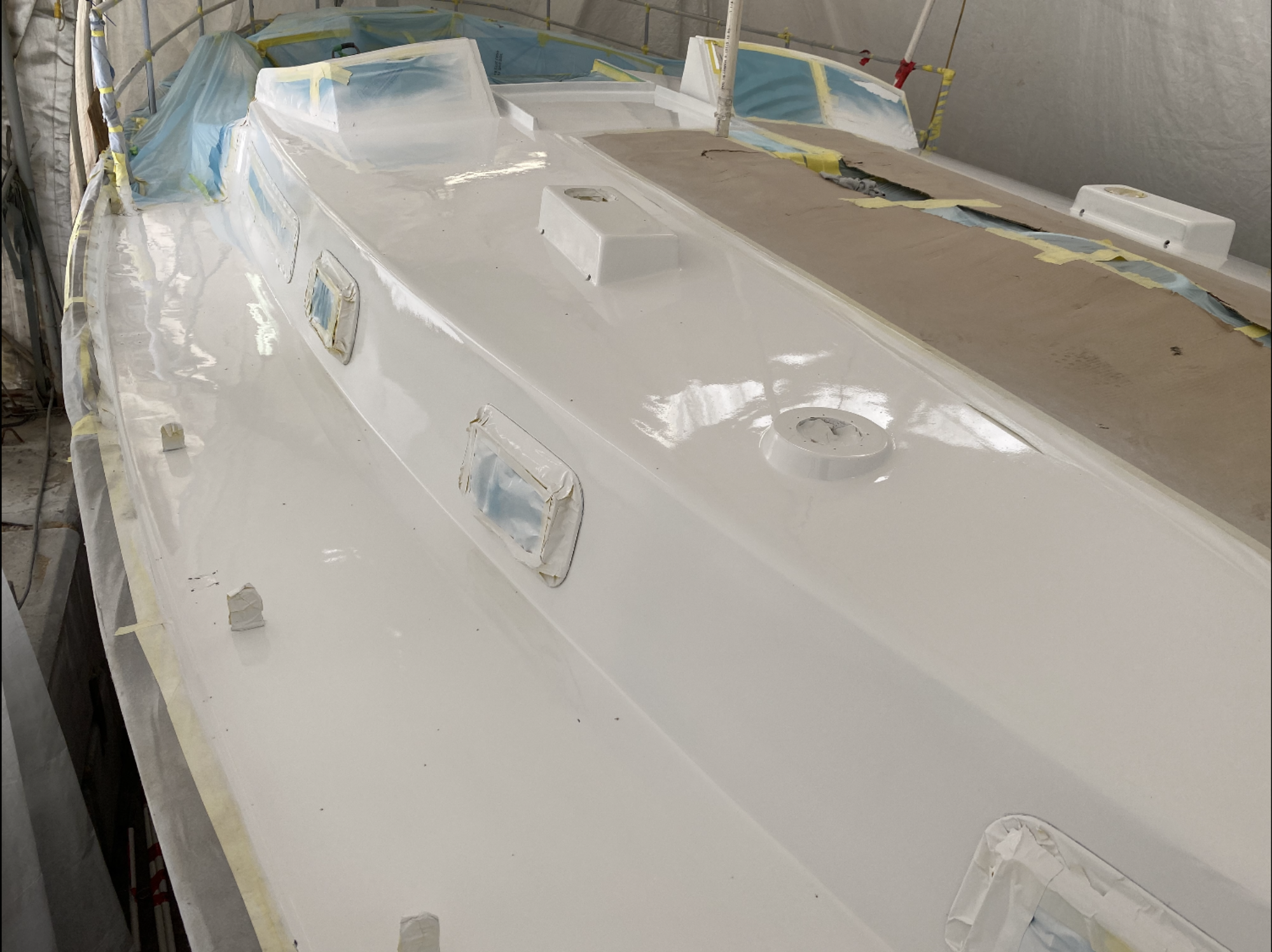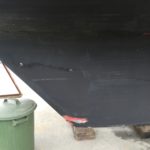
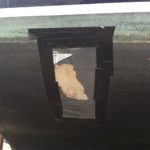
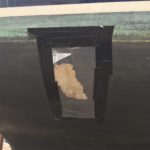
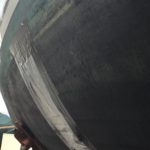
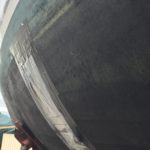 I have to admit I truly feel bad for the owner of this boat. I am not sure exactly what the make and model is but there is a very nice sailboat in the yard next to me now. It looks well kept and well loved. The top sides are spotless, the hull sides above the waterline are shiney and at first glance it is a really nice boat. Obviously as you can see in the pictures, the owner had quite the unfortunate encounter with something pretty hard. There is a big impact spot on the bottom leading edge of the fin keel and an associated large crack along the hull keel joint. This is why I do not like fin keels. If I am going to hit something and let’s face it, there are only two types of sailors, those who admit to running aground and those who lie about it, I don’t want the long heavy thing that keeps the stick end up to be ripped off. There was a letter written to Whitby Boat Works by an owner of an Alberg 30 if I remember correctly, that basically told the story of how the owner had run aground time and again and had not suffered any damage. The advice given was to move to an area with a softer muddy bottom. I am paraphrasing but it was quite humorous. The point being that the A30 was built extremely tough and the A30 and the Whitby 42 come from the same factory, at least the early ones. But I digress, I am getting a wee bit off topic.
I have to admit I truly feel bad for the owner of this boat. I am not sure exactly what the make and model is but there is a very nice sailboat in the yard next to me now. It looks well kept and well loved. The top sides are spotless, the hull sides above the waterline are shiney and at first glance it is a really nice boat. Obviously as you can see in the pictures, the owner had quite the unfortunate encounter with something pretty hard. There is a big impact spot on the bottom leading edge of the fin keel and an associated large crack along the hull keel joint. This is why I do not like fin keels. If I am going to hit something and let’s face it, there are only two types of sailors, those who admit to running aground and those who lie about it, I don’t want the long heavy thing that keeps the stick end up to be ripped off. There was a letter written to Whitby Boat Works by an owner of an Alberg 30 if I remember correctly, that basically told the story of how the owner had run aground time and again and had not suffered any damage. The advice given was to move to an area with a softer muddy bottom. I am paraphrasing but it was quite humorous. The point being that the A30 was built extremely tough and the A30 and the Whitby 42 come from the same factory, at least the early ones. But I digress, I am getting a wee bit off topic.
What really makes me feel bad for the owners of this particular boat is the large chunk of hull that fell off. Yup, fell off. I took a closer look at the bottom and was quite shocked to see the state of it. There has to be a million blisters ranging from dime to silver dollar size. Most of these blisters appear to be deep. As well, there are a couple of other older war wounds and when you step back and take an overall look it becomes clear that there is a serious layup issue. I am not a master fiberglasser or whatever you call it, but I do know that there is a proper mixture of glass and resin that needs to be obtained in order to have a strong solid build. Too much resin is as bad as too little in that the build will then become brittle whereas too little and you can end up with dry glass in the laminate. This particular boat suffers from the latter in that there are pockets of dry glass just waiting to be knocked off. It really concerns me that the owner of this boat apparently is going to fix the localized obviously damaged areas and move on when in my opinion the entire bottom needs to be peeled and reglassed if he really wants to fix it properly. That being said, I can only guess how costly this would be and I can also guess why they are not doing it. Unfortunately the blisters will continue to eat away at the hull and eventually they will be left with a beautiful top sides and no hull.
Honestly I really feel for these folks. I am not sure what I would do in their shoes. All I can say is I am extremely thankful that the previous owners of Akupara dealt with the bottom properly by having it sanded down and epoxy coated a long time ago. If Akupara’s bottom looked like this poor boat I would have never made an offer to buy her. I have enough work to do without a complete bottom rebuild as well.
Anyway I wish these people well and hope they don’t hit anything else knocking off chunks of the hull.
Just to be clear, I am not making a connection between fin keels and blisters, it just so happens that this boat suffers from both and both of which I don’t like.
